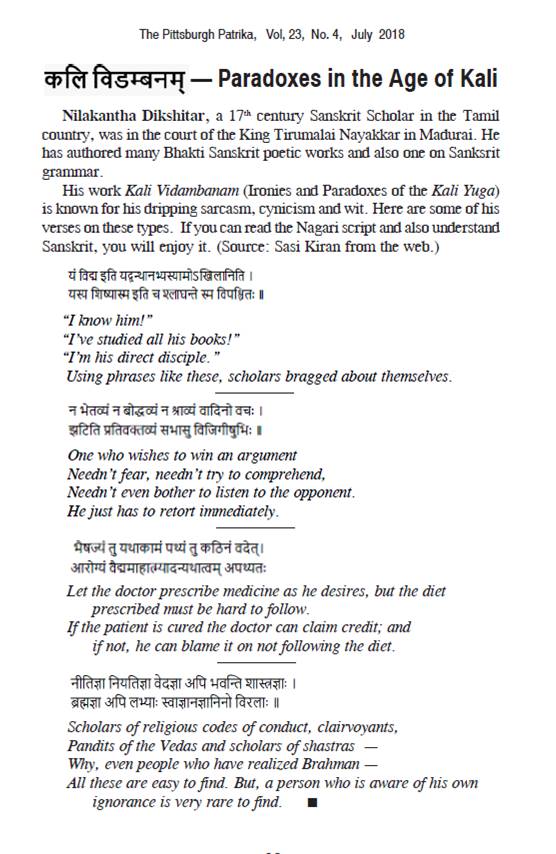Archive for category Past issues
The Fall Midterm Elections Are Important
Posted by admin in October 2018, Past issues on November 18, 2018
By Kollengode S Venkataraman
In every election, as a matter of routine, we need to show our faces at the polls to tell everyone that we take our civic duties seriously. Besides, being a relatively new group of immigrants into this these great United States, showing our faces at the polls is one sure way to slowly get acceptance into the American mainstream.
In addition to the above Boiler Plate need for us to go to the polls, the coming midterm polls this November is important for one additional reason as well.
The Pennsylvania state supreme court has redrawn the maps of the Congressional districts in Pennsylvania this year to reflect the voting patterns for offices elected by state-wide voters such as the offices for the governor, US senators, and attorney and auditor generals. We discussed this in a lengthy article two issues ago. See here for the article. In the past, the GOP-controlled Pennsylvania state legislative bodies in Harrisburg, using its majority in the state legislature and with help from the GOP governors, managed to gerrymander the Congressional district maps and gave undue advantage in sending a large contingent Republican member to the US House of Representatives in Washington, DC. Thus, in a moderately center-right state that is Pennsylvania, Republicans garnered 13-5 advantage by the blatantly skewing the congressional district maps in their favor. The redrawing of these maps is mandated to be adjusted based on population changes revealed in the decennial census.
With the redrawn maps for the congressional districts, now GOP has only a 10-8 advantage in the congressional delegation. The delegates elected in the upcoming November election is more likely to be representative of the broad electorate of the state.
So, this is one very good reason why you should go to the polls in November. Now you have a good chance to change the GOP’s skewed majority in the US House of Representatives. And may be also in the US Senate as well. So, please go to the polls this November.  ♠
Home
Kali Vidambanam — Paradoxes in the Age of Kali
Posted by admin in July 2018, Past issues on July 23, 2018
Good Bye to Swim Suit in Beauty Pageants
Posted by admin in July 2018, Past issues on July 22, 2018
Premlata Venkataraman
ThePatrika@aol.com
The Miss America contest has scrapped its swimsuit competition, striking at the most derided part of the contest. It is long overdue. Coming in the wake of the #MeToo movement that exposed sexual harassment — actually, sexual abuse — of women in many walks of life, this is a blow to the outdated, voyeuristic and prurient aspects of beauty contests.
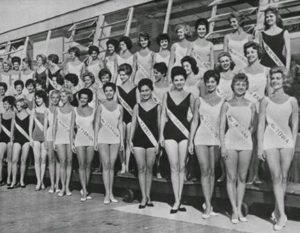
The Swim-Suit picture of Miss America 1962, staid by today’s standards.
In recent years, viewership interest — and corporate sponsorship — in beauty pageants have been dwindling in industrialized societies in the backdrop of changing social mores and attitudes between men and women and in the way society judges women. At least in public discourse, men and women in the First World rejected the idea of subjecting women to this kind of objectified evaluation in terms of the size of their bust, waist and buttocks and how well they filled a bikini. The Feminist Movement and women with professional degrees joining the work force in large numbers in the last several decades have contributed to this transformation.
Sadly, however, this contest is gaining feverish attention from emerging countries like India and China, and in Latin America, and parts of less developed parts of Europe. To capture a greater share in high-end middle class markets

By 2015, only bare essentials are covered with not much left to cover Swim Suit parade.
in cosmetics and designer apparel, global companies now sponsor these events in Asia. Never mind that it goes against the prevailing culture of modest attire in these countries.
With the Second and the Third World aping their Western counterparts in everything (see the swim suit photoshoot on the next page in the 2017 Miss India contest), here too, I am sure, they will ape the West by scrapping the bikini contest, going forward.
That is why it is important that Women’s Movements retain the cultural values of their lands, even as they work towards bringing fundamental changes to reduce gender-based violence and domestic abuse.

Indians are catching up with the West… … in this too. Miss Miss India Suit 2017.
There is a visual image associated with social workers in India. They are called jholiwalas and Jholiwalis, because they always wear simple khadi clothes with a cloth bag slung over their shoulders. To convey their important message they always wear simple cotton dresses in local designs.
I am glad Miss America 2.0 did away with the swimsuit (bikini) category. It is time women are judged not only for their attractive looks in attractive everyday clothes, but also for their wit and intelligence.   ♣
Home
Indian Poets: Cynical, Sarcastic, Humorous All at the Same Time
Posted by admin in July 2018, Past issues on July 22, 2018
By Kollengode S Venkataraman
ThePatrika@aol.com
Many short verses in Indian languages deal with honor, dharma, compassion, beauty, obligations and responsibilities, romance, love, devotion and bhakti — in high-brow and uplifting tones. But many are also known for their dripping sarcasm, cynicism, and hard realities of life.
Here are two 4-line alliterating and rhyming Tamil verses in the latter category. Nothing is known about the authors of these verses. (Source: Viveka Chintamani, editor Gna. Manikkavasagam, Uma Pathippagam, Chennai, 600 001, Year 2001). However, on the basis of the words and phrases in them, one can say that these verses cannot be earlier than 1700 AD. With Tamil having at least 2500 years of literary history, these verses are, therefore, relatively recent, only 300 years old. Here is the original of the first Tamil verse:

Here is a nonliterary translation:
Once they become adults, sons won’t listen to their fathers’ advice;
After middle age, wives wearing fragrant flowers won’tÂ
       care for their husbands;
After learning from teachers, shishyas (students) don’t goÂ
       looking for their gurus, and
Once cured of their diseases, people don’t seek their doctors.
In the above translation, if we replace “sons†with “children†to indicate both sons and daughters, and “fathers†with “parents,†It will be a lot closer to the reality of contemporary family life.
The next verse is on a topic that we all are familiar with — unsolicited advice. As parents, friends, and employees we recognize that unsolicited advice — even suggestions — is not welcome. This is the case whether we give suggestions to others, or we receive advice from others. Often, such advice breeds resentment, if not hostility, among the people involved, whether friends, colleagues, or relatives.
Such behavior in human interactions is nothing new. Here an anonymous poet explains this axiom using great wit, sarcasm, and cynicism. First the original in Tamil:

Here again is a nonliterary translation since I don’t have the skills for translating the poem into verse form:
A weaver bird, sitting in its cozy nest in rains, saw a monkey                     Â
    getting drenched, and said,
“Why don’t you build a place for yourself against the rain?â€
Irritated at the advice, the monkey got mad, went wild, andÂ
     shredded the weaver bird’s nest to smithereens.
Such is the fate of those giving unsolicited advice
     to the undeserved.    ♣
Home
Further Along the Kerala Coast… …
Posted by admin in July 2018, Past issues on July 22, 2018
By Premlata Venkataraman
thepatrika@aol.com
Driving from Coimbatore last December, we reached the Ernakulam-Kochi metro area. The roads and streets of Kochi had the usual hustle and bustle. Decades before, it was a much smaller, relaxed town. As we

Eastern Cross atop a Dwajastambham.
passed a place of worship getting a new coat of paint, we assumed they were getting ready for the upcoming Ulsavam (festival). It was a typical Kerala structure. The kodi maram (dwajasthambham), the ceremonial copper flagstaff was being cleaned; we noticed that it had an Eastern Orthodox Cross atop it. Intrigued, found that this was a Syrian Orthodox church and they were getting ready for Christmas! Now, this in a
snapshot, was the southern part of Kerala!
Serene and bucolic, Cochin has been welcoming traders, explorers and travelers to its

     Church in Alappuzha.
shores for centuries. They have left their mark — a 400-year old synagogue, churches that resemble Hindu temples and also ancient mosques set up by Arabic traders, long before the advent of Islam via the Turkic invasions. The first mosque ever built in India was in Kerala.
Of course, many old and ancient temples are open for worship with tens of thousands of devotees offering vazhipaadu (special worships) and fulfilling nerchas (vows) unbroken through very many more centuries. This setting of various places of worship reflecting so many major religions is a reflection of the makeup of the denizens of Kochi. Hindus are 44 % of the population, followed by 38 % Christians, and 18 % Muslims. There is very little religious strife in this town unlike many other cities in India. The high literacy rate of 98% in Kerala could be one reason.
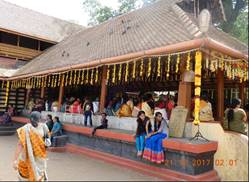
The Bhagavatghi Temple in Alappuzha.
No visit to this part of the country is complete if we do not include a boat trip on the backwaters along the Arabian coast of Southern Kerala. After a visit to the ancient Bhagavathy temple in Alappuzha, near Kochi, we went into the modern resort of Punnamada to savor the beautiful backwaters. Floating along the rivers in a small open boat with several houseboats going past us, it was idyllic. We floated past neighborhoods along very
narrow canals barely 20-feet wide and navigable only in motorized canoes. It was amazing how people have made a lifestyle along this maze of intricate waterways.
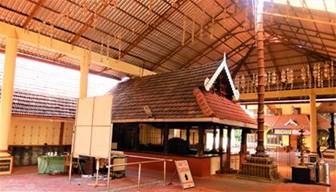
    Temple worshipped by Adi Shankara in Kaaladi.
Though the waters were clear and lapped gently along the sides, you could see the water hyacinth (an invasive species of water plant) choking the waterways and affecting the aquatic life beneath. One

          A house boat in Kerala Kaayals.
hopes they find a way to rid these pests from destroying the natural flora and fauna of the waterways.
People living in Kerala have learned to live with water. You could see cheena valas (Chinese nets in Malayalam) dotting the seashores in Kochi. (See below the picture of the nets used to catch fish.) Now they are used mainly as a tourist attraction. With abundant coastlines and

            Cheena Valaas in Kochi.
backwaters, seafood is a staple in the Kerala diet for many. People use the waterways to go to work (see the photograph below). These special ferries worked like bus routes along the waters.

    A “commuter” boat in the Kerala backwaters.
It was a near perfect vacation, though very, very short. Soothing to the eyes and the spirit, a vacation trip to Southern Kerala is a must for any traveler in South India.   ♣
Home
Federal Indictments on Five Area Healthcare Providers in Opioid Case
Posted by admin in July 2018, Past issues on July 22, 2018
By Kollengode S Venkataraman
ThePatrika@aol.com
Federal prosecutors have indicted five area physicians for illegally prescribing Suboxone, a drug meant for treating opium addicts for mitigating withdrawal-related problems. Buprenorphine, marketed under trade names Suboxone and Subutex, among others, wards off the painful symptoms of opioid withdrawal and lessens cravings. The five physicians worked as contract employees at Redirection Treatment Advocates, LLC, (RTA) a business engaged in rehab work for opium addicts.
The federal indictments allege, “… the defendants, working as contractors at various locations, created and distributed unlawful prescriptions for buprenorphine, known as Subutex and Suboxone, a drug that should be used to treat individuals with opium addiction. The defendants are also charged with conspiracy to unlawfully distribute buprenorphine.†The defendants are charged also for allegedly causing fraudulent claims to be submitted to Medicare or Medicaid for payments to cover the costs of the unlawfully prescribed buprenorphine.â€
Details of the federal indictments are here: www.justice.gov/opa/pr/five-pennsylvania-physicians-charged-unlawfully-distributing-buprenorphine-and-defrauding. The healthcare providers indicted in federal courts in Pittsburgh and West Virginia are Krishan Aggarwal, 73, and Madhu Aggarwal, 69, both from Moon Twp; Cherian John, 65, of Coraopolis; Parth Barill, 69, of Pittsburgh; and Michael Bummer, 38, of Sewickley. An indictment is only an accusation. A defendant is presumed innocent unless and until proven guilty in a court of law.
Krishan Aggarwal, Madhu Aggarwal (OB-GYN) and Parth Barill, a gastroenterologist, earned their medical degrees from Rajasthan, India. Cherian John, earned his medical degree from Mumbai.
In a statement released, the US Attorney General Jeff Sessions said, “Today we are facing the worst drug crisis in American history, with one American dying of a drug overdose every nine minutes.â€
While announcing the indictment, US Attorney for Western Pennsylvania Scott Brady said, “Expanding the legitimate use of medication to treat addiction is a critical part of this administration’s multi-faceted approach to combat the opioid epidemic ravaging our communities. Yet another vital component is the prosecution of unscrupulous practitioners who abuse their privilege to practice medicine and dispense prescriptions unlawfully. These indictments demonstrate that we remain vigilant in our pursuit of physicians who ignore their oath to do no harm.â€Â   ♣
Home
Samar Saha: An Enthusiastic Organizer of Hindustani Music, Host & Patron for Musicians
Posted by admin in July 2018, Past issues on July 22, 2018
By Shailesh Surti, O’Hara Township, PA
Shailesh.surti@gmail.com
Editor: Music lovers here know Samar and Mala Saha of Irwin as great enthusiasts of classical Hindustani music, having enjoyed many 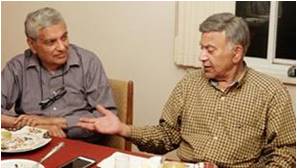 house concerts at the Sahas’ home in Irwin. In this engaging story, Shailesh Surti (left in the adjacent picture) draws out Samar Saha (right in the picture) on his exhilarating journey from his casual interest in Hindustani music to serious, passionate listener, organizer, host, and finally to patron of the music, and more importantly, of the musicians. The venue for this exchange was Shailesh’s home in O’Hara Twp, with his wife Urvashi as the gracious host. Â
house concerts at the Sahas’ home in Irwin. In this engaging story, Shailesh Surti (left in the adjacent picture) draws out Samar Saha (right in the picture) on his exhilarating journey from his casual interest in Hindustani music to serious, passionate listener, organizer, host, and finally to patron of the music, and more importantly, of the musicians. The venue for this exchange was Shailesh’s home in O’Hara Twp, with his wife Urvashi as the gracious host. Â
For any type of performing art — music and dance recitals, drama and live stage performances — to flourish anywhere, one needs art lovers, organizers, and patrons willing to underwrite a good part of the expenses above and beyond gate collections.
It is a well-recognized truism that “classical†art forms simply cannot sustain themselves merely on the basis of ticket-buying audience
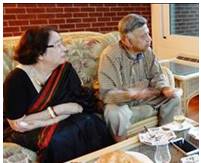
Mala and Samar Saha at the Surti residence.
support. This is the reality today both in Indian and Western performing arts. In the US, corporations and individual donors make huge contributions to symphonies and operas. In Europe, public funding for the performing arts has been the norm. In India, without corporate and government sponsors, the performing arts simply cannot survive.
 The Indian performing arts scene here: Pittsburgh has only around 20,000 Indian-Americans, with
fewer classical music enthusiasts compared even to Cleveland, which is demographically comparable to Pittsburgh on many measures. Here, Sri Venkateswara Temple has been organizing and patronizing classical Indian music concerts — especially Karnatic music — on a regular basis. Other temples also have done so in the past. Students of the Pandit Jasraj Institute of Music have organized concerts of artistes belonging to their gharana.
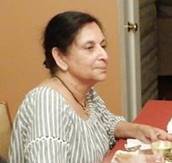
Urvashi Surti, the gracious host of the evening.
Fortunately, a few individuals, on their own drive and initiative, have been active in organizing Hindustani music concerts in Pittsburgh for a long time. For over 30 years, Dr. Balwant Dixit, under the banner of the Center for the Performing Arts of India at the University of Pittsburgh, organized many such events, both in Pittsburgh and around North America with concert tours for Indian artistes. In the early days, Dixit also organized Karnatic music programs in our town.
With Dixit now in retirement, Samar Saha and his wife Mala of Irwin have taken on the mantle for organizing Hindustani music concerts. Music lovers in our area owe the Sahas a big Thank You not only for their enthusiastic support for the art form, but also, more importantly, for their multi-faceted patronage for the artistes. The Sahas moved into the Pittsburgh area fifteen years ago after Samar retired from a job in New Jersey. Samar, a metallurgist by profession, joined US Steel’s R&D after arriving from New Jersey.
Samar had his early schooling in Banaras where he got interested in learning the tabla. But his father would not encourage him to go
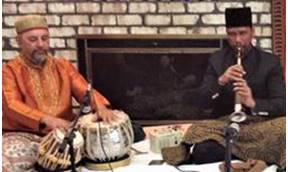
Ustad Haidar Hassan on the shehnai accompanied by Pt. Samir Chatterjee (tabla).
into music. Samar used a colorful expression to describe how his father reacted when he told his dad he wanted to pursue music.
Later, his interest in classical music blossomed when he went to college in Kolkata. During his tumultuous college days in the 1960s, with the Naxalbari Movement in full swing in Bengal, Samar managed to attend all-night concerts of artistes of great repute. His interest in cultivating a keen interest in music and musicians was greatly reinforced.
Samar even dabbled in western music in college. In 1975, he married Mala — it was an arranged marriage. Mala had her training in Rabindra Sangeet and Hindustani classical music. So it was natural both the Sahas are passionate about music.
The Sahas’ move to the US in the early 1970s directly as green-card holders was quite accidental. They settled down in New Jersey. While in New Jersey Samar became part of the Bengali Cultural Organization Kallol.
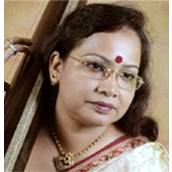
   Rajyashree Ghosh
At Kallol he introduced Hindustani cassical music concerts despite the apprehension of some members that it might not go well with their members. With the concerts well-liked by the members, Samar got first-hand experience in organizing music recitals and dealing with artistes.
The Sahas also came in contact with the tabla maestro Pandit Samir Chatterjee and his organization Chhandayan of New York. Chhandayan has been active with Indian musicians of every genus, innovating and experimenting with fusion, and tabla orchestra with vocalists. Chhandayan selects and invites artistes to perform around the USA.
With their long-standing association with Samir Chatterjee, Samar and Mala snap up opportunities to invite artistes and host them at their home. Asish and Nidrita Sinha of Cheswick are always there playing key roles in the organizing details.
Hosting artistes is not a simple job. By nature, artistes can be temperamental and picky. Receiving them at the airport, driving them around and dropping them back is a chore. But catering to their minute needs in food preferences and other needs is a different type of challenge. Samar and Mala have mastered the art of dealing with artistes.
Sometimes for a well-known artist the venue is moved to a formal auditorium, like the last concert this May of vocalist Ashwini Bhide Deshpande at the Frick’s Fine Arts’ Auditorium in Oakland. Many instrumentalists and vocalists, enjoying the Sahas’ hospitality at their home, have given their best recitals. Last year we enjoyed the Sarod player Sri Atish Mukhopadhyay accompanied on the tabla by Sri Tejas Tope. The other notable program was the nearly 3 hour memorable solo shahnai recital by Ustad Hasan Haide. Pt. Samir Chatterjee accompanied him on the tabla. Reviews of several of these recitals have appeared in the Patrika written by    knowledgeable music enthusiasts living among us.
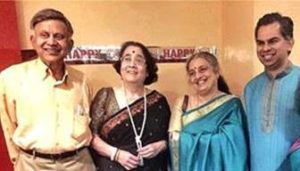
L to R: The Sahas, Ashwini Bhide and her Harmonium accompanist Kedar Naphade.
The Sahas have a lovely home in Irwin with a great room that can accommodate a small audience of up to fifty music enthusiasts to enjoy live performances. Samar has equipped his beautifully decorated home with a good sound system. Listening to the music is not the only treat at his place. The ambiance of a private house concert offers wonderful opportunities to interact with the artistes. The artistes too have said during the post-recital interactions that the sterile and formal atmosphere in large concert halls is no match for the instantaneous rapport they make with their audience sitting only feet away from them in house concerts. The concert is always followed by a scrumptious dinner, usually organized in potluck fashion with many in the audience bringing home-cooked delicacies.
The Sahas take great pride in hosting talented, young artistes, who give their very best in trying to establish themselves in the field. Many of them will never forget the Sahas’ patronage. The Sahas also encourage our own home-grown talents like vocalist young Ayan Sinha. Here are some of the artistes who have performed at the Sahas’ place:
- Padma Bhushan Pt. Buddhadeb Dasgupta (Sarod) opened the house concert with his blessings for success. His son, Anirban Dasgupta, another Sarod player played with him. August, 2012.
- Flutist Steve Gorn — April, 2013
- Classical Vocalist Mitali Bhowmik — May, 2014
- Thumri, Dadra and Ghazals by Rita Ganguly and Sitarist Amie Maciszewski — October, 2014
- Classical Vocalist Samarth Nagarkar — May 2015
- Thumri, Dadra and Durga Vandana Singer Rajyasree Ghosh — October, 2015
- Sitarist Abhik Mukherji and Flutist Jay Gandhi Jugalbandi — April 2016 (during the wedding reception of the Sahas’ daughter, Elena)
- Classical Vocalist Sanjoy Banerjee — April, 2017
- Shehnai Haidar Hassan – son of Shehnai Nawaz Late Ut. Ali Ahmed Hussain Khan -— May 2017
- Sarodist Atish Mukhopadhyay — October 2017
- Classical Vocalist Ashwini Bhide — May 20, 2018
Without letting anybody know (until now), very often, the Sahas, like true patrons of arts, have contributed from their own resources, a lion’s share of the total expenses for many of these concerts. This is in addition to hosting the artistes in their home for several days before and after the recital.
That they are Hindustani music enthusiasts is well-known. Further, without any institutional support here, and on their own strength, they are also warm hosts, efficient organizers, and generous patrons of the art and the artistes, all rolled into one. The Sahas are unique in this respect.  ♣
Home
Consul General of India Visits the Asian Studies Center at Pitt
Posted by admin in July 2018, Past issues on July 22, 2018
The Asian Studies Center at the University of Pittsburgh was delighted to host the Consul General of India, Mr. Sandeep Chakravorty, on March 28th and 29th 2018. The Consul General was invited to by the University of Pittsburgh for a major conference “Rethinking South-South Cooperation: India and Brazil in the 21st Century,†organized under the auspices of the University Center for International Studies.
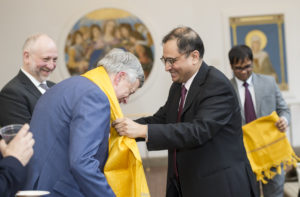
Consul General Sandeep Chakravorty facilitates Pitt’s Chancellor Emeritus Mark Nordenberg with a traditional Indian scarf. Extreme left is Vice Provost of Global Affairs Ariel Armony,
In conjunction with this, the Consul General of India participated in a series of events focused on the development of Indian Studies, toured the Indian Nationality Room in the Cathedral of Learning and met with a group of students representing a tremendous cross-section of interests in Indian Studies in particular and South Asia more broadly. Mr. Chakravorty and his staff have been extremely helpful in working with senior leadership at the University of Pittsburgh, and with Ms. Riva Ganguly Das, Director General of the Indian Council for Cultural Relations, to establish the ICCR Chair in Indian Studies.
Over the course of the next five years, this important initiative will bring leading scholars from universities in India to the University of Pittsburgh to teach courses that focus on Indian society and culture in the humanities and social sciences.
The ICCR Chair in Indian Studies will serve to anchor and help to develop an important initiative. Recognizing the growth and development of South Asia, the Asian Studies Center at the University of Pittsburgh is committed to expanding faculty research and teaching expertise on the global significance of this significant region of the world.
Beyond the academic significance of the “India Initiative†at the University of Pittsburgh, the establishment of the ICCR Indian Studies Chair will serve as an important bridge to the community.
In conjunction with this goal, Consul General Chakravorty was able to meet representatives of Pittsburgh’s community who have contributed to Indian studies over the years, most especially those who have played a vital role in building and supporting the Indian Nationality Room  ♣
Home
The Wadhwani Institute of Artificial Intelligence Inaugurated in Mumbai
Posted by admin in July 2018, Past issues on July 22, 2018
By K S Venkataraman
ThePatrika@aol.com
Sunil Wadhwani and his wife Nita are well known in our region’s city and county governments and civic institutions. He was the founding CEO of i-Gate, a global software company, known in its previous incarnation as Mastech, a company he co-founded with Ashok Trivedi. At the peak of his career as the CEO of i-Gate, over 30,000 employees were on its payroll in 70-plus offices worldwide with over $1 billion in annual revenue.
In the middle of this, Sunil took great interest in promoting Pittsburgh, a second-tier US City, as the destination of choice for national and international businesses to relocate or open their offices. At the same time, Wadhwani also worked with city and county elected officials to diversify the region’s population making it attractive for immigrants, a feature that global businesses consider desirable in their decision to relocate or open a new office in a new place. After all, our region has all the accoutrements needed — affordable housing, good public and private schools, excellent medical facilities, universities, sports teams, museums, and other entertainments…
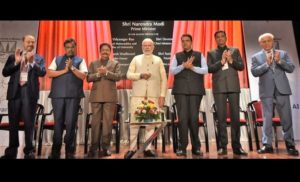
Sunil Wadhwani is extreme left and his elder brother Romesh Wadhwani is extreme right. Maharashtra’s Governor Mr. C Vidyasagar Rao is third from left and Chief Minister Mr Devendra Fadnavis is third from right, on the stage during the inaugural function. Prime Minister Modi is in the middle.
In 2015, Capgemini, a French IT services company, acquired i-Gate for over $4 billion. Now, Wadhwani is in semi-retirement, yet active in running SWAT, a venture capital company based in Moon, as a managing partner, along with Ashok Trivedi.
“Most of us who grew up in India and moved to the US have been extremely fortunate. We had parents who cared for us and had the means to educate us in good schools and send us to the US. Many billions of people around the world — especially those struggling in poverty in India and other developing countries — are not so lucky. It is up to us to help our fellow human beings who have not been as blessed.†Sunil’s thoughts have been drifting along these lines for quite some time.
So he decided to put a small portion of his resources to good use in India, with possibilities of having a global impact. Joining with his older brother Romesh Wadhwani, a California-based venture capitalist, the two Wadhwanis each donated $15 million and founded the Wadhwani Institute for Artificial Intelligence (WIAI). The thrust of the Wadhwani Institute is “harnessing the power of AI to solve deep-rooted problems in healthcare, education, agriculture, and infrastructure to accelerate social development.†Though the institute’s beneficiaries can be global, its immediate focus is on the Indian subcontinent and Asia, where it is most needed, and where the impact can be high.
In March of this year, in Mumbai, the Wadhwani Institute of AI went on-stream, with India’s Prime Minister Narendra Modi inaugurating it in the presence of the Maharashtra Chief Minister Devendra Fadnavis, its Governor Vidyasagar and many other dignitaries. In the opening ceremony, Modi said, “The Wadhwani AI institute is a prime example of how the public sector and the private sector can come together with good intentions to build a world-class institute, aimed at benefiting the poor.”
Sunil said, “The government of Maharashtra has committed land, but the details are still being worked out. Currently, ten full-time employees are working at the institute, which is likely to go to 30-plus full-time employees specializing in AI in three years.†Around one hundred researchers from affiliated institutes outside India will be working on AI applications for social good at the institute.
The Wadhwani Institute, a fully independent body, will be closely working with the University of Bombay to develop a master’s program on Data Sciences and AI.
In a press release on the occasion, Sunil said, “AI is a game-changing technology. There’s a lot of research being done at companies like Amazon, Google and Alibaba, and at universities like Carnegie Mellon and MIT. However, virtually all of that is targeted at commercial applications, and there’s little or no research on how to use AI to accelerate social development. Our goal is to have, within the next two years, over 100 researchers working on leveraging AI to improve the quality of life for the bottom two billion people in the world.† So founding this institute is gratifying to the Wadhwani brothers and their families.
Responding to a question, Sunil said, “The institute is looking for hiring the best AI researchers from around the world who are also passionate about social development. Because of our location in India and our initial focus on applying AI to social development in India and other developing countries, most of these have been of Indian origin so far. As we expand, we expect our workforce to become more global in nature.â€
Continuing, he said, “We are forming partnerships with the world’s leading AI research institutions to work together on applying AI to accelerate social development. We have already formed such partnerships with MIT, Carnegie-Mellon University, New York University, the University of Washington, and the University of Southern California.
As part of the launch of the institute in March in Mumbai, Wadhwani Institute hosted a summit of seventy-five leading AI researchers, social sector experts and senior government officials to identify challenges that could be addressed using AI. Ideas discussed included using AI to help farmers on when they should plant their seeds for best crop yields, improving the effectiveness of community health workers, addressing high dropout rates in rural schools, making educational content available in local languages and dialects, and facilitating the early detection of diseases.
Indeed, ambitious objectives for social good on many fronts. ♣
Home
Our Region’s First Nonstop Flight to Asia
Posted by admin in July 2018, Past issues on July 22, 2018
By Kollengode S Venkataraman
ThePatrika@aol.com
After considerable effort, the Allegheny County Airport Authority finally succeeded in cracking into the Asian aviation market with a chartered nonstop flight to Shanghai, operated by China Eastern Airlines, starting this August. One hopes that the charter nonstop flights to Shanghai is just the beginning for Pittsburgh International to get nonstops to other Asian destinations. It must grow into a seasonal and then regular three or four weekly flights all year around.
This nonstop came with a price tag for the region: The airport authority is pitching in up to $560,000 to subsidize the flight. This is essentially tax-payer money. That amount will drop  when Pittsburgh travelers purchase tickets, according to the Authority’s spokesman Bob Kerlik.
 In addition, the VisitPittsburgh tourism agency is kicking in another $300,000, with another $50,000 coming from the Idea Foundry, a Pittsburgh-based nonprofit that works with Chinese families and students to encourage educational ties and investment.
In addition, the VisitPittsburgh tourism agency is kicking in another $300,000, with another $50,000 coming from the Idea Foundry, a Pittsburgh-based nonprofit that works with Chinese families and students to encourage educational ties and investment.
The subsidies are part of a three-year agreement with Caissa Touristic, the tour operator, to market and sell trips to Pittsburgh. However, the flight currently is guaranteed for only one year.
Remember, in the heyday of US Airways at Pittsburgh International we had daily nonstop and direct service from PIT to Paris, Frankfurt, London, Rome, London, Milan… … And then the sky fell for us when US Airways walked away from its hub here, only to eventually disappear altogether from the skies. Recently Pittsburgh International inaugurated nonstops to Europe through WOW and Condor airlines.
The Patrika has written on the need for connecting PIT to Asia with nonstops for our region to encourage businesses to relocate here. However, anybody who is even peripherally familiar with the commercial aviation industry knows that the center of gravity of commercial airlines has shifted to Asia (Singapore, Thailand, Malaysia, China, and India). The commercial airline industry will grow for the next several decades in this region domestically, regionally, and even globally. Europe and North America are saturated markets.
The Big-Three US air carriers — United, Delta, and American — dominate global nonstops through their hubs across the US. Working to get American or other large European air carriers to introduce nonstops from Pittsburgh International to Europe and Asia is just a waste of time. That is why airlines from China, India, South East Asia, and the Persian Gulf countries has become attractive for Pittsburgh International to get nonstops to Asian destinations.
China Eastern Airlines nonstop seasonal charter service connecting Pittsburgh and Shanghai, China commences on August 3. This is the region’s very first nonstop air link with China, or for that matter, the the whole of Asia. Pittsburgh will be the arriving and departing gateway for hundreds of Chinese tourists visiting the U.S. East Coast this summer.
“This is a fantastic opportunity for our region to become the first medium-size city in the country as a destination for Chinese tourists,†Allegheny County Executive Rich Fitzgerald said. “Our region’s businesses, the airport, and our tourism industry will be the primary beneficiary of this agreement.â€
China Eastern will fly its flagship Boeing 777-300 ER, carrying 316 seats in a first/business/economy three-class configuration. The first departure from Pittsburgh will occur the same day as its landing.
“This is huge step forward for the future, particularly for nonstop air service to China. The charter-to-scheduled service model has been successfully adopted in other parts of the world,†said Christina Cassotis, Pittsburgh International Airport CEO. “We are the first U.S. market to tap into China’s fast-growing tourism market with this type of business model.â€
Pittsburgh area travelers will be able to purchase tickets on these flights through www.Travel2.com and www.firstinservice.com. Flights start at just $1,098 inclusive of tax and fees. Travel2 has also put together land packages starting as low as $990 when booked in conjunction with these flights. For all bookings, inquiries, terms, and conditions contact michelle@fls.com or call 310-435-3977.  ♣
Home
Trump’s Bravado Is Counterproductive
Posted by admin in July 2018, Past issues on July 22, 2018
By Kollengode S Venkataraman
ThePatrika@aol.com
As a New York real estate tycoon and casino owner in Nevada, Donald Trump’s management style was to keep his subordinates, competition, vendors, clients guessing, and spring surprises in meetings to have an upper hand. But it did not always work for him. His businesses filed for Chapter-11 bankruptcies six times. Trump’s ad hoc working style and blowing hot and cold unabatedly followed him to the Oval Office on appointments, domestic and trade policies, and foreign affairs. This style is bad for running the behemoth called the Government of the United States, whose tentacles in military alliances, intelligence operations, business/trading interests, are spread all over the world.
So, managing US relations with allies and trading partners, and dealing with threats and enemies require a steady hand at the helm to diplomatically coordinate the policies. Thousands of dedicated government officials work for him doing the groundwork for months, even years, to build consensus on complex, sensitive issues, so that in summits, leaders can sign agreements on issues on substance under good optics.

The other G-7 leaders confronting Donald Trump at the G-7 meeting in Canada in May 2018.
Trump’s adhocism on policies makes it difficult, to put it generously, for officials to negotiate on his behalf. He erratically turns the rudder wheel of the huge ship of the State with bluster, as he did in the G-7 meeting in Canada in June. The confrontational picture describes the acrimony in the meeting.
President Trump may think — even believe — that the brashly displaying American raw power in summits will make US allies genuflect before him and scare hostile nations into submission. The “Sole Super Power†sobriquet for the US will be honored by allies — and feared by enemies — only if the US uses its power with discretion and finesse. His bluster and bravado weaken the alliance, only making Russia and China happy.
Even in domestic politics, one wonders if Trump is helping or hurting the GOP by his brazenness. — By KSV
Home
India’s One Quintessential Salesman
Posted by admin in April 2018, Past issues on April 4, 2018
By Kollengode S Venkataraman
Last December [2017], I was in Coimbatore, in Tamil Nadu, a self-made city built by the enterprising instincts of Kongu Vellalars (Gounders) and Naidus, the two major communities that pretty much built the city and the region surrounding the city from scratch, with practically no support from federal or state governments or investments in public sector companies. The medical care facilities in primary, secondary and tertiary healthcare in Coimbatore is as good as it is in Chennai, only less expensive.
[One important observation in diversion: Private sector doctors do not care – and perhaps do not even want primary and preventive health care. After all, with poor emphasis and priority on primary care with its emphasis on preventive medicine, in due course of time, everybody ends up in secondary and tertiary health care facilities, costing several multiple times compared to what preventive care costs. By far one of the most predatory health care systems in the world is in India.) That is where all the money is to be made for the healthcare industry in India — doctors, testing labs, pharma companies, and a horde of healthcare support services. The tertiary healthcare facility is the ultimate akshaya patram for the doctors and hospitals. Many working class families without access to hard currency from their sons and daughters in the Persian Gulf, Malaysia, Singapore, and the Gora lands, are on the brink of financial ruins.  This is another topic for another day.]
Kongu Vellalar’s (Gounders’) and Naidus’ footprints are everywhere in Coimbatore and its surrounding area – in elementary, primary, secondary education in schools they have build in the names of their parents; 4-year colleges in arts and science; medical and engineering colleges; hospitals, primary care centers and charities in their parents’ names; small and medium businesses and industries; and in supporting temples and patronizing performing arts. In the arid Kongu region where one needs to go 300 to 400 feet deep to get water, these people of the region also engage in farming and agriculture. That is how hardworking and enterprising the people in the region are.
We were in the shopping area along Hundred-Feet Road in Coimbatore looking for a Pattu Paavaadai (reshmi lehnga) for my 3-yar old grand daughter. Hundred-Feet Road had several showrooms for silk saris and gold/diamond jewelry. These shops specializing in silks only sell the fabric in pure Kanchi and other specialty silks for Paavaadais for 2 to 12-year old girls. The Paavaadai fabric, like expensive saris, comes with matching material for the blouse integrally woven at one end of the fabric.
My wife and I were debating how the green pavadai would go with the pink/red blouse material for our 3-year old brown grand daughter. The salesman heard our discussion: “Ayya, oru nimisham,†or “Sir, wait an minute.†He continued in Tamil: “I will show you how it would look as a paavaadai-jaaket pair.â€
I don’t know what he did, or how he did it. Within 30 seconds, he folded the single piece of silk fabric in a few complicated steps. Bingo! Magically, he made the same piece of fabric look like a paavaadai-blouse pair.
“Ayya, ippa parunga.†Or, “Sir, now you see.†With a smile on his face, he continued in Tamil, “This is how it would look on your grand daughter.â€
I asked him to pose for a picture. And here it is.
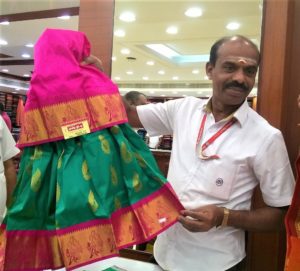
Needless to say, he was so good, I also ended up buying more material than what I had in mind when I entered the shop. ♣
Home
Young Men and Women in India Choosing Their Partners on Their Own Is Nothing New
Posted by admin in April 2018, Past issues on April 4, 2018
By K S Venkataraman
    Young Indian men and women in the US or in India increasingly choose their own partners now. Parents are usually informed that they are “seeing someone†who they met in college/at work/on online dating sites. In the due course of time, these youngsters eventually settle down in life with their choice of life partners.
Young men and women choosing life partners on their own is not entirely a new phenomenon in India. Literature dated 2500 years before our time has poems describing the lament of parents over their daughter leaving with her beloved without even informing them! Here is an example.
    Aga-Naanooru is an anthology of 400 verses in classical Tamil. Here is the verse in Aga-Naanooru in the original, by the poet Karuvoor Kannambalanaar. (Reference: Aga-Naanooru by Puliyoor Kesikan, Pari Nalayam, Chennai, Verse 263):
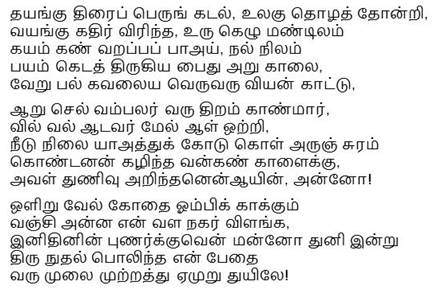
The verses in Aga-Naanooru are dated between 600 years BC and 300 years AD. (Incidentally, the UN has declared Tamil as a classical language of the world. The other UN-recognized classical languages are Sanskrit, Mandarin, Greek, Latin, and Hebrew. India is the birthplace of two of the world’s classical languages.)
    The language in these verses is old classical Tamil that most Tamils of today cannot understand without the help of commentary by scholars. The gist — not a translation — of the verse is this:
   The Sun making waves in the oceans is worshipped all over the world, But this summer, it has dried the lakes and ponds, making the rich farmlands fallow, thus plunging farmers into poverty.Â
    In this hot summer, along a trail through the forest used by people to go from one village to another, in an area with thick foliage, thieves with bows are hiding on higher branches of tall trees to rob travelers.Â
    My innocent daughter has left my house eloping with her lover, and now has to travel through the dangerous forest… …
    The neighboring City of Vanji is well protected by Kothai, its courageous spear-bearing king. Even my prosperous farmland is as safe as Vanji. If only I had known my daughter’s love for her beloved, willingly and without any ill feeling and rancor, I would have arranged the marriage of my virtuous, innocent daughter with a lovely, bright forehead such that her beloved can rest his head on the valley between her still-growing breasts and sleep. Alas! I cannot do this for her now.
    So, relax and take it easy if your wards go on their own in choosing their life partners. This has been the way of the world all over. Besides, there is nothing else you can do about it anyway!  ♣
Home
Weekend in the Only Ice Hotel in Quebec City
Posted by admin in April 2018, Past issues on April 4, 2018
By Rahul Dilip Tendulkar, Shaker Heights, Ohio
Editor’s Note: Rahul Dilip Tendulkar was born and raised in Grand Blanc, MI. He went to medical school 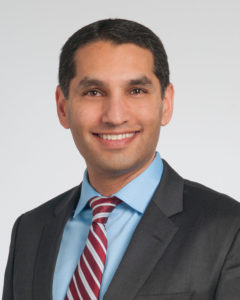 at the University of Michigan, and finished his residency in radiation oncology at the Cleveland Clinic, where he is at the Taussig Cancer Center. He married Rajani, daughter of Arvind and Deepa Koimattur of Monroeville. The Tendulkars and their two daughters live in the Cleveland Metro area. Rahul enjoys traveling, publishing papers and tennis.
at the University of Michigan, and finished his residency in radiation oncology at the Cleveland Clinic, where he is at the Taussig Cancer Center. He married Rajani, daughter of Arvind and Deepa Koimattur of Monroeville. The Tendulkars and their two daughters live in the Cleveland Metro area. Rahul enjoys traveling, publishing papers and tennis.
My wife Rajani, daughter of Deepa and Arvind Koimattur of Monroeville, was born on a cold and snowy January day in Pittsburgh in 1978. Naturally, she wanted to spend her milestone 40th birthday not on a warm beach, but rather in an environment similar to the day of her

Rahul and Rajani with their kids in the hotel lobby.
birth. So our family planned a special trip to visit the Hotel de Glace just outside of Quebec City, Canada, which is the only ice hotel in North America. Accompanied by her daughters Parisa and S
amira, myself, and her parents Deepa and Arwind Koimattur, we packed our bags with extreme cold weather gear to withstand the arctic blast that weathermen were predicting to sweep through the continent.
The Hotel de Glace, which is only open from January to March each year, is constructed by local artists who spend weeks putting together the massive structure out of snow and blocks of ice. Like a giant igloo, the indoor temperature remains surprisingly constant around 25 degrees F despite the subzero wind-chill temperatures outdoors.
The hotel is an architectural phenomenon, with a bar, a chapel, and forty-five
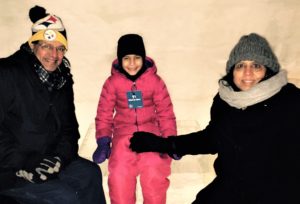
Aravind Koimattur enjoying the freezing cold with his wife Deepa and grand kid at the ice hotel.
distinctive guest rooms. The bar area was equipped with bright LED lights, dance music, a fireplace, and drinks served in glasses made of ice — it was quite the party! Intricately designed ice sculptures were there in every corner and even hanging from the arched ceilings.
Each bedroom was uniquely crafted, with beds made of ice and topped by a comfortable mattress with sleeping bags of the same kind as used by explorers
to the North Pole. We carefully tucked in the children first and zipped them up so only their eyes and noses were exposed. Getting ourselves into the sleeping bags proved to be even more tricky, but once we were able to zip ourselves in, our bodies (except for our faces) were remarkably comfortable. As parents, we didn’t sleep much that night, but our children slept like babies. We all woke up with a sense of accomplishment having survived a night outdoors in the coldest place we have ever visited! It was certainly an occasion to remember for the January birthday girl.  ♣
Home
A Memorable and Nostalgic Train Journey
Posted by admin in April 2018, Past issues on April 4, 2018
By Premlata Venkataraman   Â
e-mail: ThePatrika@aol.com
 Home, country, kinship can mean different things at various stages in your life. Confusing? Maybe not. For those of us who were born in one nation, but now call another our home, these concepts have been shifting. Ponder this: for many of us going to India on our first visit after being here for several years, it brings forth choking emotions of nostalgia, love for the place and people, self-doubt on our leaving India, even patriotism. However, after a few decades of living in the ‘Burgh, when returning from India, just a glimpse of the Three Perennial Rivers from the plane before landing gives us the relief and comfort of being home.
Home, country, kinship can mean different things at various stages in your life. Confusing? Maybe not. For those of us who were born in one nation, but now call another our home, these concepts have been shifting. Ponder this: for many of us going to India on our first visit after being here for several years, it brings forth choking emotions of nostalgia, love for the place and people, self-doubt on our leaving India, even patriotism. However, after a few decades of living in the ‘Burgh, when returning from India, just a glimpse of the Three Perennial Rivers from the plane before landing gives us the relief and comfort of being home.

Mangalore Junction.
With nostalgia, after thirty years, last December, I created an opportunity to travel through the lands where my parents were born and lived until adulthood — small-town Kerala they were from for generations before moving to Bombay, where they raised a family.
We settled on an 8-h long train journey along the West Coast of Southern India from Mangalore to Coimbatore. I had taken this route at least ten times from childhood through my young adulthood. People talk about the past flashing before their eyes. As the train was gently going past several small stations, memories of past images gushed past in my mind as I was looking through the window!

Coconut palms just 50 yards away from the railway track.
We boarded the train early in the morning at Mangalore Junction after going to the famous Mookambika and Udupi Temples. As the early sun was drenching the landscape with light, the train was gently going past a land of coconut groves densely dotting the green paddy fields. Acres and acres of green fields, stretched on a land watered by plenty of streams and rivers. Backwaters washed over the land, with bobbing fishing boats headed out to the Arabian Sea visible through the window.
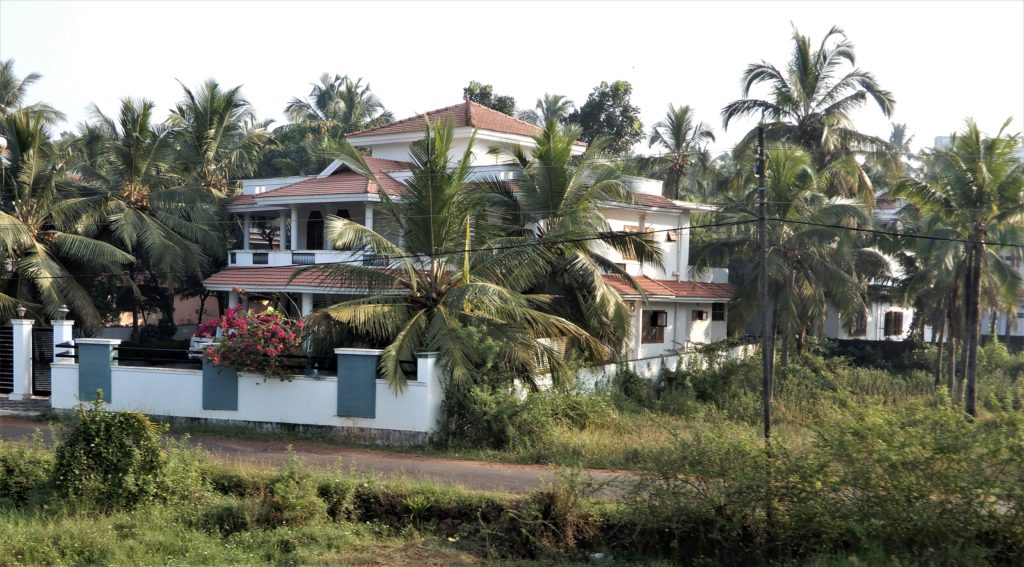
One of the countless homes along the track nestled around coconut palms.
The scene was so reminiscent of the many trips I had taken in my childhood traveling from Bombay to Kerala to visit grandparents and family. I distinctly remember now, as you enter Kerala from Coimbatore, the changing landscape from Tamil Nadu was so sudden and dramatic. That is why India has so many diverse languages and food preferences.
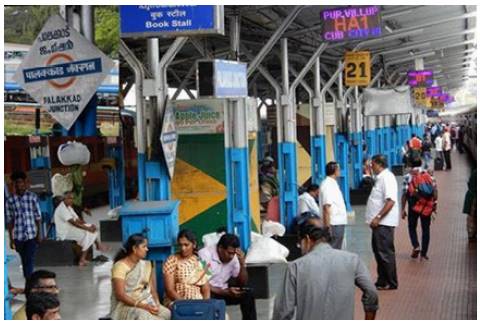
Palakkad Junction, nostalgically familiar to those from Kerala.
We passed through Kannur where my maternal grandfather taught mathematics and accounting at the European High School — the grandfather, I remember, wore a linen jacket and a cotton turban. We moved on to Thallassery, famous for black pepper, the home of my mother and her large family, onto Mahe, my father’s hometown. The train chugged on through Badagara where my parents lived for a short time before moving to Bombay. I re-lived the many stories told by my relatives at several family gatherings in my childhood.
About the Indian railways in South India: Having traveled in European and US trains, I must say, the Indian Railways system does an amazing job, when you consider that over 10 million people are on long-distance trains every day, and how relatively affordable the second-class tickets are to average Indians. A great improvement in the trains is new toilets that collect waste products, like in airplanes, leaving the railway tracks en route clean.
Ticket purchase is now as easy as on-line booking of airline tickets. The tickets give all the information of compartment number, (as the rail cars are called in India), its placement on the station platform and seat numbers. You are able to board the train with comfort and with no anxiety. The railway platforms in big stations are typically 1000 yards long. South Indian train stations are clean with enough seating for weary travelers. The longest trains, with 24 rail cars, are over 650 yards long.

Verdant paddy fields in front of coconut palms — a common sight in central Kerala.
The railway staff was courteous and professional. A new development that pleased me was: all employees at stations waving the trains off were women in smart uniforms! Also, now women are in the driver’s seat, running the heavy electric locomotives in suburban trains as well.
The range and quality of food at the South Indian railway stations did not disappoint me. The food and newspaper stalls are all privatized, with lots of local delicacies. Snack packs of salty banana chips, cookies, halwas, crackers, and murukkus are available everywhere.
We had appam and stew for breakfast at the station. Our boxed lunch of rice, sambar and yoghurt too were served fresh. Nonvegetarian lunches too are available. One suggestion if you are travelling in long-distance trains: Take paper napkins, fork/spoons and bottled water before leaving home; and also some large trash bags to put all the waste you will generate.
The short 8-hour ride through a familiar, beautiful route made me nostalgic. So, if you have the time and the opportunity, travel in a long-distance train in India along a route familiar to you from your younger days. It is far more interesting than sterile air travel. It will bring back memories that you thought you’ve forgotten long, long ago.  ♣
Home
A Real Life Humorous Story — How I Became An Artist
Posted by admin in April 2018, Past issues on April 4, 2018
By Mahendra Shah  Â
e-mail:Â mahendraaruna1@gmail.com
Editor’s Note: After earning his degree in architecture from the MS University in Vadodara, Gujarat, Mahendra Shah, migrated to the U.S. in 1974. Mahendra, a successful entrepreneur and businessman for many years in real estate and retail businesses, is an enthusiastic contributor to the Pittsburgh Indian community. Over the years, he has recorded his humorous observations on immigrant Indians in America in more than 1500 cartoons. He is also keenly interested in poetry, essays and paintings. His work was originally published by Pittsburgh’s Gujarati magazine and is now featured in several publications and exhibitions.
 I was in the 10th grade. Our Gujarati literature class was studying Saraswatichandra, an epic four-volume text written by Govardhanram
I was in the 10th grade. Our Gujarati literature class was studying Saraswatichandra, an epic four-volume text written by Govardhanram
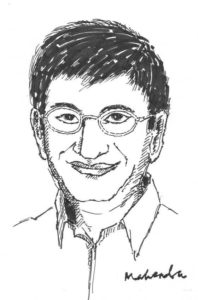
Mahendra’s self portrait.
Madhavaram Tripathi. The story is about love, wealth, business, and family. Once a week our teacher, who was also our principal, taught one chapter at a
time. He narrated the story in such a lively fashion that you felt as if the entire scene was being played out right in front of you.
Growing up shy and somewhat reserved. I preferred to sit in the back of the classroom trying to avoid answering questions. I often wandered off into my own thoughts.
In one class the teacher began reading the story in which Saraswatichandra was going from his village to meet his fiancee in her village. He was walking through a wooded forest and ran into a poisonous snake.
As I was listening to the story unfold, my mind began to wander in its usual fashion. I began to doodle in my notebook, at first somewhat aimlessly, but then, the teacher’s words grabbed my attention. As he began describing the poisonous snake creeping closer and closer to 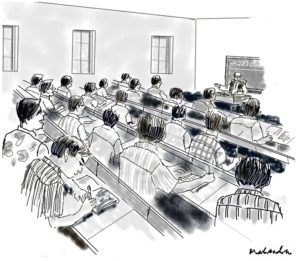 Saraswatichandra, I started imagining and drawing the whole scene as a pencil sketch.
Saraswatichandra, I started imagining and drawing the whole scene as a pencil sketch.
All other students were mesmerized by the teacher’s reading of the story. They were frozen in their seats in anticipation of what was to come next. The room was absolutely still except for me. My eyes were glued to my notebook as my fingers were busy doodling and drawing out the scene that the teacher was narrating.
Suddenly, the teacher’s eyes set on me and he noticed that unlike the other students, my attention was not fully on him. He stood from his chair and menacingly stared at me. I was frozen stiff. I was certain I was in an enormous amount of trouble. I had never been this frightened in my entire life.
He knew I was doing something in the notebook. He called me to his desk. As I rose from my chair, raising his voice, he said, “Bring your notebook too. I want to see what is so important that it drew you away from my lesson.â€
I approached the teacher with my notebook and was terrified of what would come next. Immediately, he asked me to hand over the notebook and opened it to the page full of my doodles. 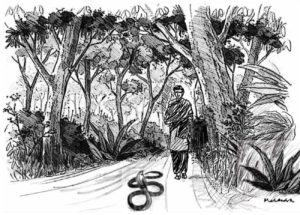 As he looked closer and closer at my notebook, his face stiffened. I was sweating in fear. I was expecting the worst.
As he looked closer and closer at my notebook, his face stiffened. I was sweating in fear. I was expecting the worst.
Several seconds passed as he riffled through all the pages. Slowly, I saw that his frown was gone. When he finally began to talk, he showed the entire class my sketch of the story. He praised my drawings and said that they were the best narration of the story!
I felt such a sense of relief. Not only was I not in trouble, but from that day on, I was known as the “Resident Artist†of the school. I was commissioned to execute all art-related projects — posters, banners, and others — for school events.
After my education, I married and came to the United States. The responsibilities that came along with work and family made me put my art on the back burner, but I always kept doodling or sketching in my spare time.
Our children had grown and started lives of their own. Several years ago my daughter and son-in-law were visiting us. They had just moved to a city only a couple of hours from Pittsburgh.
When I returned from work in the evening, I was surprised to find my daughter exploring my art portfolio. It had been sitting in the attic for years, and I had nearly forgotten about it. In fact, we were preparing to move to a new house, and the album was meant to go into the trash pile!
My daughter asked, “Dad, would it be alright if I take a few pieces of your artwork with me?â€
“Of course, you can. I was going to throw those away anyway.â€
A few weeks later, we went to visit them in their new apartment. When we entered the house, to my utter surprise and delight, I saw a few of my paintings and drawings hanging nicely on the walls. They were framed aesthetically too. I was so touched. It felt wonderful to have my art appreciated again after so many years by my own children..
Her simple act of appreciating my forgotten paintings inspired me to return again to my childhood passion of being an artist. Â ♣
Home
Francis Cleetus’ Vibrant Paintings on Display
Posted by admin in April 2018, Past issues on April 4, 2018
By Kollengode S Venkataraman
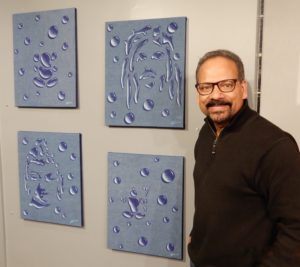
Francis Cleetus happily poses for the Patrika in front of one of his painting collections.
On a wintry January evening, the Greater Pittsburgh Arts Council organized a Gallery Crawl for lovers of the visual arts to “crawl†from one venue to another to enjoy the works of Pittsburgh-based creative minds at several galleries and public places. The artists were also present to answer questions; music programs and a comedy improv also were part of the crawl. Part of the crawl was the works of Indian-American visual artist Francis Cleetus at the gallery at 810 Penn Avenue downtown.

Cleetus has brought 3-d effect simply by imagina-tively using the effect of light and shadows in a 2-d painting. Do you see a Ganesha in this?
Cleetus was born in Bombay (now Mumbai). “Even from my early childhood, I always had interest in visual arts,†he says. He helped friends with their drawing-related homework assignments at school. He says, “My dad, who worked for Reader’s Digest, encouraged me in my pursuits.â€Â Cleetus went to St. Pius High School in East Bombay, where his English teacher Mary D’Souza encouraged his creative pursuits. She was his inspiration.
After earning his bachelor’s degree in chemistry from the University of Bombay, he worked as a chemist at a tire company. He soon realized that was not his calling. He went on to earn his diploma in Advertising Management from the Advertising Agencies Association of India. While working on multi-media campaigns for clients, he kept his creative instincts alive. Along the way, he won awards at agencies like Draft FCB, J. Walter Thompson, and Doe Anderson in India. He

A painting of Cleetus shows a snake in 3-d.
developed his style as a painter, designer, illustrator, cartoonist and sculptor. But Cleetus had no formal education or training in visual art. His talents are instinctive, endowed by Mother Nature.
After living in Hong Kong for nine years with his wife Maneesha, Cleetus joined MARC Advertising as its Creative Director in Pittsburgh.
A few years ago, when Phipps Botanical Conservatory organized Tropical Forest India, a 3-year live exhibition, Cleetus’ mandala-type painting decorated the roof of the South-Indian-style entrance created by our own Sthapathi Ayyachami Narayanan of Monroeville.
Cleetus is currently with Mylan’s global creative & design services team working on logo designs, print ads, billboards, digital ads, websites, exhibitions and more.
When asked why all of his paintings on display are inspired by Indian themes, his reply was quite simple and direct: “Because that’s who I am.†  But his sculptures and drawing also have universal themes in terms of imagery.
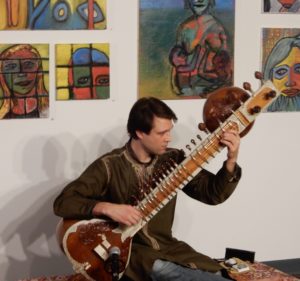 On the inaugural day, Michael Griska was on the sitar adding to the excitement and enjoyment. See the picture on the side.
On the inaugural day, Michael Griska was on the sitar adding to the excitement and enjoyment. See the picture on the side.
Cleetus lives in Upper St Clair with his wife Maneesha and two daughters, Ananya and Antara. More information about Cleetus is here.
Visitors can see Cleetus’ works at the Karmalogue Gallery during weekdays’ by arranging appointments with Christiana Leach at the Greater Pittsburgh Arts Council (GPAC) at 412.391.2060 Ext 228. The next Gallery Crawl is on April 27 from 5:30 PM till 10:00 PM, when you can see the works of other artists in galleries and other public places.  ♣
Home
Nandini Mandal: Inspiring Journey in Dance Through Challenges
Posted by admin in April 2018, Past issues on April 4, 2018
By Dolly Luthra and Juginder Luthra, Weirton, WV
Nandini Mandal has now become synonymous with a talented dancer, teacher, brave and resilient survivor, and a cultural ambassador of India in Pittsburgh. It was a long, difficult but exhilarating journey.
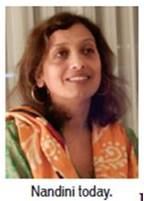
We have known the ever-smiling Nandini since she came to Pittsburgh. She was not a household name when she landed in Pittsburgh from India in 1995. She being from Bengal, her talents were first recognized in the Bengali Association of Pittsburgh. Very many years ago, she was invited to give a performance for the Annual Triveni Family Variety Program. Her amazing dance pieces are still talked about. Just as a rooster cannot take credit for the sunrise, Triveni International cannot take credit for the trajectory of Nandini’s rise in the area; it was just one of the many platforms.
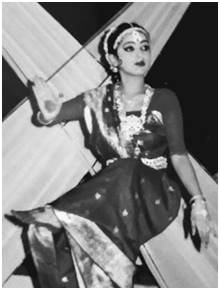
It did not take long for Nandini’s creativity to be known to all Indians — and also non-Indians as well — in Greater Pittsburgh Area.
Even as a young child she stomped and broke into dancing to the beat of music and ghungroo. The inborn talent was quickly recognized by her pare
nts. Her mother, a school teacher, took Nandini to dance lessons. Her father, working in the Indian Railways in Kharagpur, too was very supportive. She started getting formal dance training when she was seven. In 1983 she obtained Junior Diploma in Hindustani Classical music. She earned her Senior Diploma, Sangeet Prabhakar, from Allahabad University with distinction in Bharatanatyam at the age of 14 under Guru Snigdha Pal. In the same year she completed her Arangetram. She also got training in Kathakali, Manipuri, and Nava-Nritya. Credit for the variety of dances in India, she tells, goes to traders and invaders who added new touches to the already existing Natyashastra-based dance traditions.
Later, when she continued her education in Calcutta, her passion for dance followed. She trained at the Kala Mandalam focusing on Bharatanatyam and Nava-Nritya.

Her Bharatanatyam was Tanjavoor School (Gharana). Her structured courses on the theory of Indian dances at college were extremely helpful when she took practical classes under traditional teachers.
After her marriage, she came to Pittsburgh where her husband was employed in the early boom period of the IT industry in the US. The Mandals are blessed with two daughters.
She founded the Nandanik Dance Academy and the Nandanik Dance Troupe in 19

98, where she is the director since inception. She teaches Bharatanatyam, Nava-Nritya, Folk, and contemporary dances. In her classes in Pittsburgh, she tries to teach her students the theoretical foundations to the extent possible.
In life, nothing goes up in a straight line. She developed aplastic anemia which required multiple blood transfusions. Her Indian friends in this town gathered together helping her in many ways — anything from arranging food, monetary help for the long duration of hospitalization and medical care, and social support for their beloved Nandini aunty teacher, mentor and friend, and her betis. This, combined with her grit and determination to live to full under very trying circumstance and share her God-given gift with children and adults, made Nandini survive through the ordeal.
Due to her sickness she lost movement in her thigh bone joint. This required joint replacement. For any dancer, this generally means end of dancing career. But Nandini is not any dancer. Her obstacles did not stop there. She continued with her dance, while restricting her acrobatic moves.
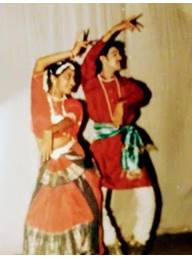
In the middle of all this, she developed an aggressive form of Acute Mylogenous leukemia. The only cure was bone marrow transplant. Her social network once again went into full gear searching for a compatible donor all over the world. An anonymous donor’s marrow matched. She went through a successful surgery, followed with chemotherapy and a lengthy recovery period. She was fragile, having to raise two daughters.
She endured through all this with her grit and smile, and she was able to beat the disease, usually associated with high mortality rate. She credits her survival to the excellent timely care by cancer experts in New York and well-earned social support she received from friends. The strong will to live also critical.
All through this, simultaneously she was struggling with personal issues too. She and the family survived this bitter part of their life as well. She credits her father’s support and for her and positive attitude for coming out of the many challenges.
Nandini continues to pass on her talent to her own daughters and hundreds of children in the Tri-State Area. She has given solo and group performances in and around Pittsburgh, and in other states in the US and India as well choreographing several dance programs. Her numerous activities include being an Art Activist, Event Planner and manager, Interpreter and Translator…

She spreads her understanding of dances, music and various facets of India in numerous schools in and around Pittsburgh. As the cultural ambassador of India with World Affairs Council’s Pittsburgh Chapter, she did a series of lectures at schools in Allegheny and Washington counties. She actively has collaborated with local artists such as Mary Miller, Africa Yetu and Dr. Sheila Collins.
She has performed dances in the presence of Mother Teresa, Dr. A.P.J. Abdul Kalaam, and India’s Air Chief Marshall where she raised funds for the fallen soldiers.
After receiving so much help from society, she is conscious that she needs to give back to the society. Her fundraising activities include Light the Night Walk for Leukemia Lymphoma Society, Dance for Cure for the American Cancer Society Relay for Life. A video of her choreographed dance is being used in India to help raise awareness for need of sanitation facilities for girls. A still photograph of this video, taken with the fountain at the Point State Park in the background was on the cover page of the Pittsburgh Patrika.
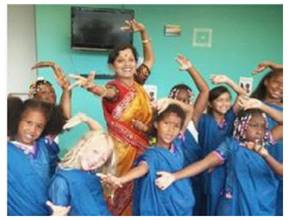
Nandini is one of the recipients of the Artist Opportunity Grant of 2016. Due to the efforts of Nadanik Dance Troupe, the Mayor of Pittsburgh issued a proclamation declaring November 14, 2014 as Prakriti Day.
Recently, in February 2018 her efforts and talents were recognized by the Pittsburgh Art Council. She is the first Indian/American to receive a grant of $12,000 for the production of Vilaya.
She feels bad that with so many high-caliber professional dancers living and actively performing in Pittsburgh, the community prefers to invite outsiders, glossing over the “Local” artists. Her dream is to one day perform in larger well-known theaters in Pittsburgh. Wo subah kabhi tho zaroor aayegi (Someday that morning will definitely come!)
In addition to teaching and choreographing dance programs, she enjoys reading, listening to good music and gardening. There is not a dull moment in her life.
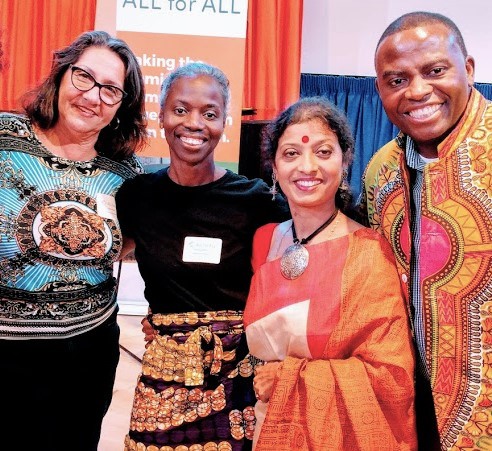
Nandini declares, “Humans start dancing when they are born. Just watch the movements of babies.” Her motto in life is “Push forward and do not give up.”
Pittsburgh is richer and a better place to live for Indians because Providence brought Nandini to live among us to realize her dreams here. We wish her success in every sphere of life. ♣
Home
History of Tax Reform
Posted by admin in April 2018, Past issues on April 4, 2018
By Kris Gopal    e-mail: gutcut@comcast.net
As our present government scurried to create a new tax code before the end of 2016, it will be worthwhile to know how the tax code evolved in this country.
The first income tax bill was introduced in 1861 as a one-time event to raise money for the Civil War, which the then president Abraham Lincoln signed into law the same year. It was meant to be a temporary measure with a flat tax rate of 3% on annual incomes above $800 (equivalent to ~ $22,000 per year income today).
 In 1862 congress created what would become the Internal Revenue service. This tax law lapsed in 1872, and there was no income tax till the year 1894 when congress passed law to in recreating income tax code. At that time the Supreme Court by vote of 5-4 voted that the income tax code was unconstitutional. A progressive reform group fighting to reintroduce the tax code led to the passage in 1913 of a constitutional amendment – the 16th amendment – legalizing federal taxation. The first implemented permanent tax code had a top rate of 7% on annual incomes above $500,000 which would be equivalent to $12.5 million today.
In 1862 congress created what would become the Internal Revenue service. This tax law lapsed in 1872, and there was no income tax till the year 1894 when congress passed law to in recreating income tax code. At that time the Supreme Court by vote of 5-4 voted that the income tax code was unconstitutional. A progressive reform group fighting to reintroduce the tax code led to the passage in 1913 of a constitutional amendment – the 16th amendment – legalizing federal taxation. The first implemented permanent tax code had a top rate of 7% on annual incomes above $500,000 which would be equivalent to $12.5 million today.
The U.S. Government later passed a massive tax hikes to pay for the world War I, including the first version of the estate tax, and raised the taxes yet again to finance the enormous costs of World War II. In 1944 the top income tax rate peaked at 94 percent on taxable income of over $200,000 (about $2.5 million today).
In 1963 President John F Kennedy slashed the top rate for individuals from 91 percent to a more reasonable 65  percent. This reduction met with still resistance from conservative Democrats and Republicans who worried about the deficit it will entail. When Lyndon Johnson became the president after Kennedy’s assassination, the Revenue Act of 1964 was passed lowering the top individual tax rate to 70 percent and the bottom rate to 14% from 20%. At the same time the corporate tax was also lowered from 52%to 48%.
percent. This reduction met with still resistance from conservative Democrats and Republicans who worried about the deficit it will entail. When Lyndon Johnson became the president after Kennedy’s assassination, the Revenue Act of 1964 was passed lowering the top individual tax rate to 70 percent and the bottom rate to 14% from 20%. At the same time the corporate tax was also lowered from 52%to 48%.
Another seventeen years elapsed before the next tax reform took place under President Ronald Regan. He created the biggest tax cut by slashing the top individual rate from 70% to 50%. He and his advisers revamped the tax code and introduced the 1986 Tax Reform Act simplifying the tax and reduced fifteen tax brackets to just two, 15% and 28% percent. This tax code also eliminated $60 billion tax loopholes. It was felt to be revenue neutral.
To appease few resentful congressmen and senators, Reagan increased the standard deduction to benefit low-income families. He also increased the capital gains tax from 20% to 28%.
Then in 1991, the then citizen Donald Trump told congress that the new tax reforms had been “an absolute catastrophe for the country.â€
President George W Bush pushed through a major tax cut in 2001. Later Democratic presidents have raised the top tax rate to 39.6% and the number of tax brackets was expanded to seven and several new tax breaks and loopholes were been added.
During President Donald Trump’s first year in office, the Republican controlled House and Senate succeeded in rewriting the tax code. After cantankerous debates both in the House and Senate, the Republicans managed to pass the bill, solely along the party-line vote. It was necessary to raise the debt ceiling. The new tax bill reduces the corporate tax from 35% to 21%. It reduces personal tax bracket from eight to seven. It reduces individual taxes to many Americans. The new bill increases the personal standard deductions from $12,000 to $24,000. The present bill reduces the property taxes and state taxes deduction to $10,000. It reduces mortgage interest deductions for new houses up to $750,000. Some changes were also made in the estate taxes, and alternate minimum tax, and gift taxes.
The new budget increase spending on defense, infrastructure improvements, mental health care, and Catastrophic Fund. This new tax law will not be budget neutral and will leave an enormous deficit. Congressmen of the future will have to reconcile with this huge budget deficit.
References:
The library of Congress. Business Reference Service. compiled by Ellen Terell. https://www.loc.gov/rr/business/hottopic/irs_history.html
The US. and International Media. Vol 17 issue 848
https://www.irs.gov/about-irs/brief-history-of-irs
https://www.loc.gov/rr/business/hottopic/irs_history.html
https://www.infoplease.com/business-finance/taxes/history-income-tax-united-states
https://en.wikipedia.org/wiki/Taxation_history_of_the_United_States   ♣
Home
A Level Playing Field for Electing Pennsylvania’s US House of Representatives
Posted by admin in April 2018, January 2018, Past issues on March 2, 2018
By Kollengode S Venkataraman
e-mail: ThePatrika.@aol.com
The US Congress, as required by the US Constitution, has 435 Members in the House of Representatives, elected from 435 electoral districts from 50 states. Each Congressional district must have approximately the same population (~ 720,000 people).
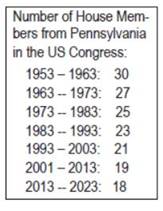
Consequently, states gain or lose House seats depending on the changes in the population determined by the decennial cenÂsus. The population of Pennsylvania relative to the population of the nation has been declining throughout the second half of the 20th century. Hence the number of House seats from Pennsylvania has been shrinking. See the adjacent table. Reference: https://tinyurl.com/Penna-US-House-Seats
Congressmen are elected from each state from “Congressional DisÂtricts,†which are specific geographical areas within the state. The map for each district is redrawn every ten years. The Pennsylvania legislature’s General Assembly (lower house and the senate) in Harrisburg has the authority to redraw the map after each census. However, the governor has to sign off on what the General Assembly proposes.
Pennsylvania is a Moderate State, Relatively Speaking: In elections for the US president and US Senate, the vote split between Democratic and Republican candidates has been between 45:55 or tighter swinging either way. We have voted both for Republicans and Democrats in presidential elections; we have had both Democratic and Republican Governors and US Senators. So, Pennsylvania is a moderate state, relatively speaking.
The 18-member House delegation is skewed towards Republicans. However, if you see the split between the two parties Congressional delegation from Pennsylvania, it is nothing but a scandal. Look at the numbers of GOP and Democratic Congressmen in recent elections from the state:
————————————————————————————————
Election Year and GOP-Democrat Split:
2010: 12-7
2012: 13-5
2014: 13-5
2016: 13-5
————————————————————————————————-
That is, Republicans have 67% of the state’s 18-member Congressional Delegation to the US House, even though the state votes 48-52, swinging either way in presidential and Senate races. The perpetual grip of the Republican majority in the Pennsylvania general assembly garnered such a disproportionately skewed advantage in the US Congress by gerrymandering congressional district maps. They did this by banding and breaking voters identified to vote against them.
Banding: Segments of voters, mostly urban, well known to vote Democratic (for example Blacks, Jews, Asians) would be herded together into very few districts such that in these districts Democratic candidates would win with an 80%-plus majority.
Breaking: Where it suits them, Republicans have drawn the district maps dispersing Democratic voters in a densely populated urban area into multiple Congressional districts thus diluting their effectiveness against them, and gaining a clear advantage for winning in the general elections.
In many districts, once you win in the primary, you coast to victory in the general election. The intra-party primaries are where the battle is won or lost. To know what gerrymandering is, just look at the example of the 7th congressional district, near Philadelphia shown below.
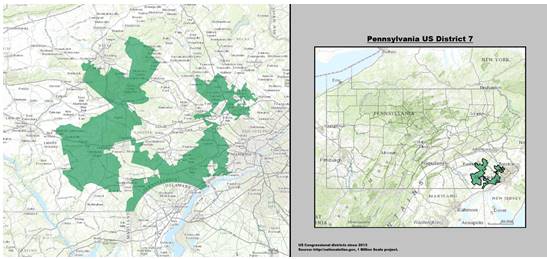

The state’s ~12.75 million population is clustered around urban centers like Philadelphia (6.0 million), Pittsburgh (2.4 million), and Allentown (0.8 million). The state’s population density is shown in the picture below:
The map of the Congressional districts of the last several election cycles is also shown below. The rural districts are large because they are sparsely populated. This way of drawing the districts gave a disproportionate advantage to the Republicans for winning 13 of the 18 House seats from Pennsylvania’s more than 2/3 of the seats.
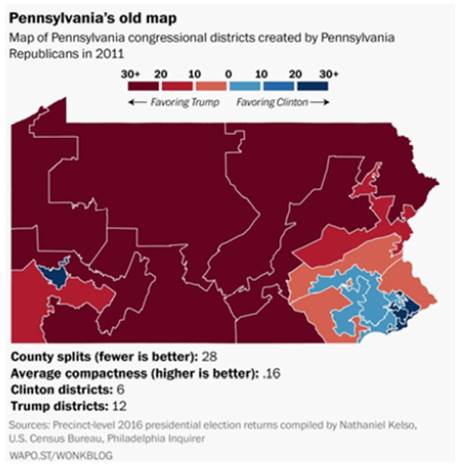
Republicans have been in the majority in the Pennsylvania General Assembly for years. This time, a Democrat (Tom Wolf) is the Governor in Harrisburg. Understandably, the governor did not sign off on the Republicans’ gerrymandered redistricting map. When the issue went to the state Supreme Court the League of Women Voters filed the law suit, the court asked the General Assembly to revise their redistricting map, because the Republicans’ plan was “aimed at achieving unfair partisan gain.” The revised redistricting map of the General Assembly too was not endorsed by the Democratic governor.
So, the state Supreme Court took it upon itself to redraw the congressional districts. With the help of a Stanford University professor, the Court redrew the map, saying the map is “superior or comparable” to all the submitted proposals, and is based on “traditional redistricting criteria of compactness, contiguity, equality of population, and respect for the integrity of political subdivisions.” It is a 4-3 decision in the 7-member state Supreme Court. The court-made map is shown below:
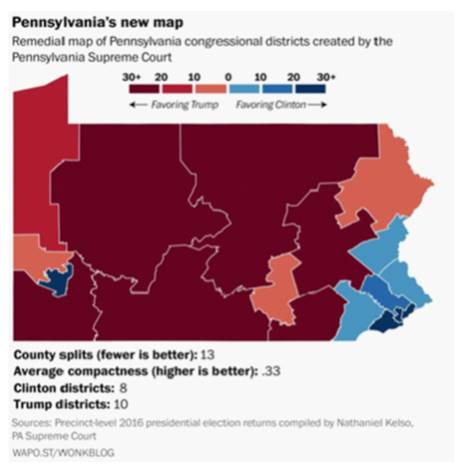
Based on votes cast in the 2016 elections, the new map gives a 10/8 split between the GOP and Democrats compared with the disproportionate 13/5 advantage the GOP now has in the Congressional delegation.
With a more level playing field now imposed by the Pennsylvania Supreme Court, the 2018 mid-term elections to the US Congress in the state become more competitive, representative, and also equitable, in the context of the voting pattern in the state.
We thank the state Supreme Court for correcting the grossly unfair way the GOP-controlled General Assembly in Harrisburg gerrymandered Congressional districts. This and similar decisions in other states correcting the blatant gerrymandering by both parties can finally moderate the partisan deadlock we have been seeing in Washington for the last two decades.
Acknowledgments: The two colored maps of the Congressional districts are from the Washington Post. ♠

